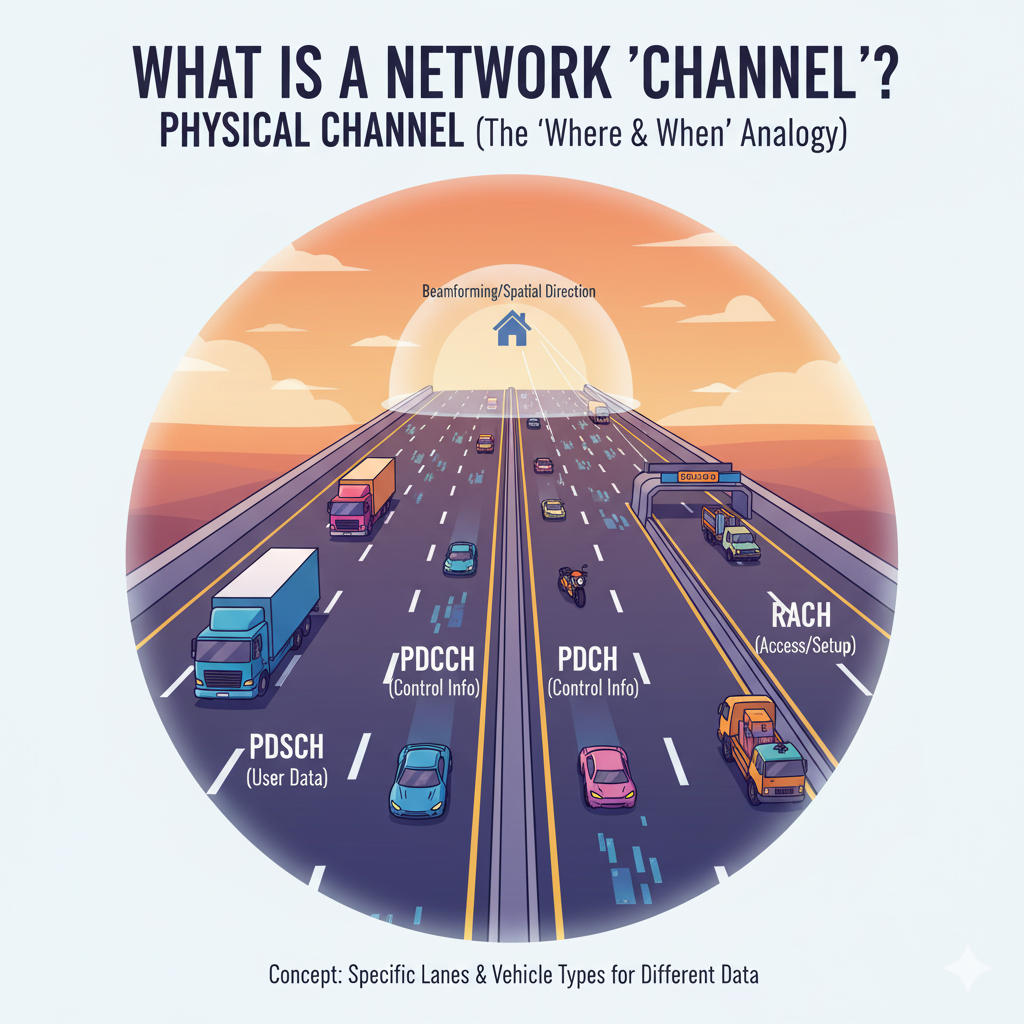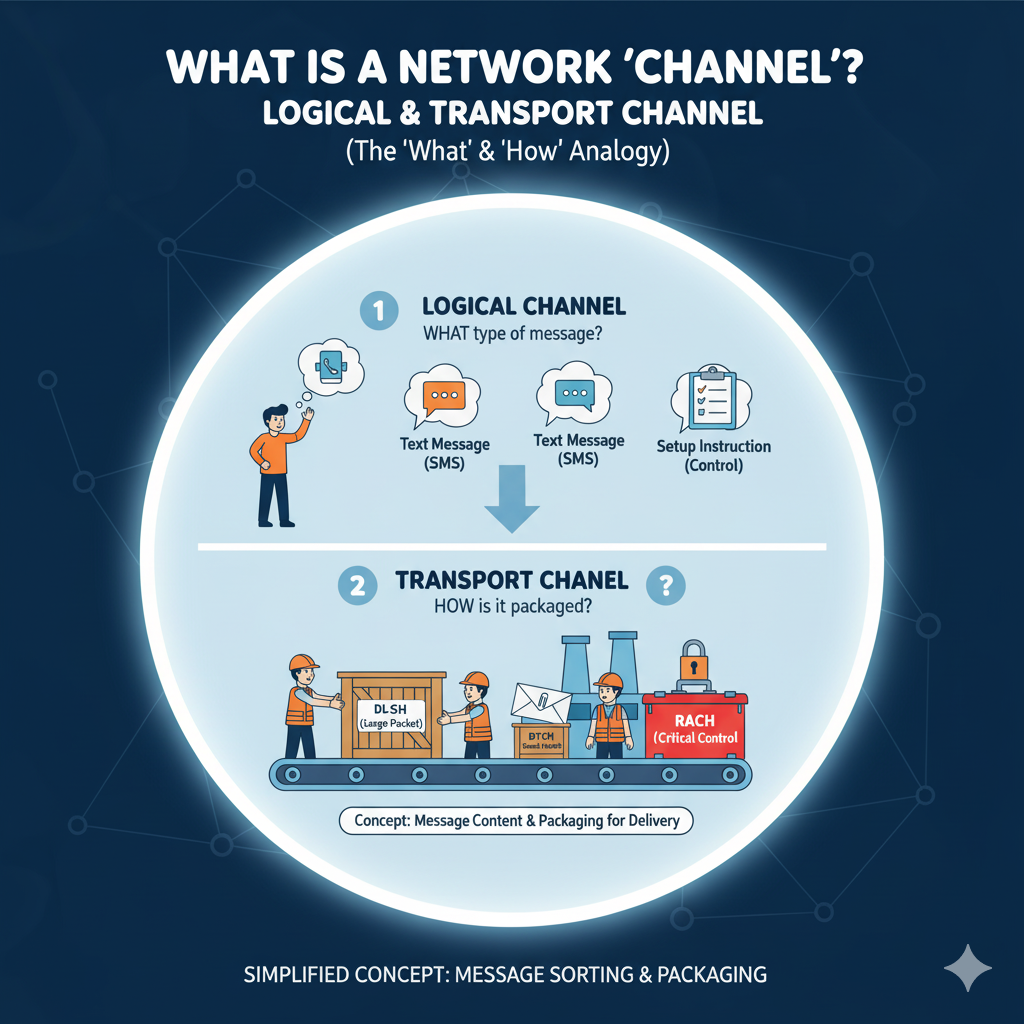Channel, Channel …
, , 2025
Channel, Channel … - A Concept of Wireless Communications
Touching on the fundamental concepts of wireless communication systems, you need to know “Channel”
What Does “Channel” Actually Refer To?
Term “channel” is abstract. It exists on different layers of the communication protocol stack. But in wireless systems like LTE and 5G NR, the term “channel” doesn’t always refer to the same concept. It can mean:
| Type | Description | Example |
|---|---|---|
| Physical Channel | Actual radio signals transmitted over the air, carrying encoded information. | PRACH, PDSCH, PUSCH |
| Logical Channel | Type of information being carried (what the data means). | BCCH, PCCH, DCCH |
| Transport Channel | How the data is transferred between MAC and PHY layers (how it’s mapped to the physical layer). | DL-SCH, UL-SCH, RACH |
1. The Physical Channel (Physical Layer - PHY)
A Physical Channel refers to the specific, dedicated time-frequency-spatial resources on the air interface used to transmit data.
- What it is: A defined set of $\text{OFDM}$ subcarriers, $\text{OFDM}$ symbols, and often a specific precoding (beamforming) vector used to carry information.
- What it does: It carries the actual raw bits over the radio waves. Examples: $\text{PDSCH}$ (Physical Downlink Shared Channel) and $\text{PDCCH}$ (Physical Downlink Control Channel).
- Analogy: The specific lane on a highway and the type of vehicle (truck, sedan, etc.) that can use it.
 *Physical channel = the actual radio transmission over the air. Illustrated by highway with vehicles.
*Physical channel = the actual radio transmission over the air. Illustrated by highway with vehicles.
2.The Logical or Transport Channel (MAC/RLC Layers)
Logical and Transport Channels refer to the type of information being carried and how it is organized for delivery, independent of the physical radio resources.
- Logical Channel: Defined by the type of content (e.g., user data vs. control information). Examples: $\text{BCCH}$ (Broadcast Control Channel) and $\text{DTCH}$ (Dedicated Traffic Channel).
- Transport Channel: Defined by the physical layer characteristics (e.g., how the data is coded, interleaved, and mapped). Examples: $\text{DL-SCH}$ (Downlink Shared Channel) and $\text{RACH}$ (Random Access Channel).
- Analogy: The content of the message (a text message, a phone call, or a setup instruction) and how it’s packaged (small envelope, large box).
 *Logical channel = the content (e.g., “control message” or “user data”) *Transport channel = the packaging method
*Logical channel = the content (e.g., “control message” or “user data”) *Transport channel = the packaging method
 *Figure taken from here which illustrate the 5G SA Initial Attach Sequence In Detail
*Figure taken from here which illustrate the 5G SA Initial Attach Sequence In Detail
Reference: https://www.sharetechnote.com/html/5G/5G_CallProcess_InitialAttach.html
If you notice at above figure SSB/PBCH flow from BS to UE, why it called SSB/PBCH?
The components of SSB
An SSB contains four elements:
| Component | Type | Purpose |
|---|---|---|
| PSS (Primary Synchronization Signal) | Signal | Helps UE detect cell ID (NID2) and achieve time/frequency synchronization. |
| SSS (Secondary Synchronization Signal) | Signal | Completes the full cell ID (NID1 + NID2) and helps with frame timing. |
| PBCH (Physical Broadcast Channel) | Physical Channel | Carries the MIB (Master Information Block). |
| PBCH-DMRS | Reference Signal | Helps the UE demodulate PBCH. |
So, the SSB is a composite structure:
SSB = PSS + SSS + PBCH (+ PBCH-DMRS)
In the hierarchy looks like this:
SSB (Signal Block)
├── PSS (Signal)
├── SSS (Signal)
└── PBCH (Physical Channel)
└── MIB (Logical Channel Data)
To clarify, here’s what actually happens when a UE first powers on:
| Step | Transmission | Description |
|---|---|---|
| ① | gNB transmits SSB burst set periodically | Contains PSS, SSS, PBCH (MIB) |
| ② | UE detects PSS/SSS | Synchronizes and gets Cell ID, frame timing |
| ③ | UE decodes PBCH | Extracts MIB (and PBCH payload) |
| ④ | From MIB, UE learns where SIB1 is located (PDSCH time/freq resources) | UE obtain SIB1 which is broadcast proactively and periodically by the gNB |
| ⑤ | UE decodes SIB1 | Gets RACH configuration and other access info |
| ⑥ | UE performs RACH procedure | Starts communication with gNB |
